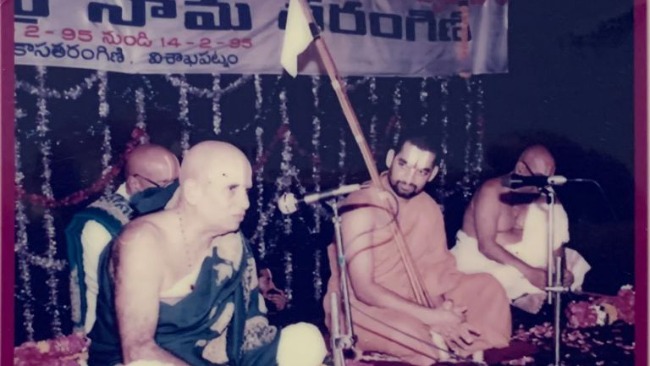Sribhashyam Appalacharya Swami was an unparalleled scholar who built intellectual bridge between scripture and truth seeker.
Appalacharya Swami once clarified a line in a popular verse from Bhagavatha Mahathmyam. This is one of the examples of how he built the bridge between those who seek truth and the scriptures.
agnou thishtathi vipra:na:m
one who studied Vedas sees God in fire and meditates through fire oblations
yogina:m hrudaye: ravou
one who is a yogi sees God in his heart or the Sun and meditates accordingly
prathima:su aprabuddha:na:m
one who is “not wise” sees God in an idol/deity
(read complete article for the correct interpretation)
sarvathra samadarsina:m
one who has equal perception sees God everywhere
The third line in the verse about who worships God in the form of deity seems to be conflicting with the greatness of alwar-saints (blessed poet saints of Southern southern India). Hence, requested Appalacharya Swamy to clarify…
Explain how the third line seems to cause conflict…
Observe the words of the third line, prathima:su aprabuddha:na:m, looks like it says that the idol worship is for those who are unwise. Prathima means a pleasant form. Buddhi means knowledge, prabuddhi means full knowledge, aprabuddhi means no knowledge. Hence, the line means that idol worship is for those who have no knowledge. If so, are alwars unwise? If they are unwise, why would they be revered and worshiped time immemorial for having experienced the eternal supreme truths outpoured in the form of divya prabandha, the divine literature?
For example: Thiruppan alwar had the darshan of Lord Ranganatha in a majestic reclining position. He was captivated by the form and outpoured several verses that revealed the nature of God. After ‘seeing’ God as Ranganatha in Sri Rangam, he was so deeply connected to the God’s reclining posture that he did not even desire to see God in any other position such as seating posture. Form was critical to his experience!

How did Appalacharya Swami clarify this conflict?
Sages include a krama (order) when teaching the truths. The four lines, beginning from the first line to the fourth line depict an ascending order of a person’s matured state in the path to spiritual experience.
First line: agnou thishtathi vipra:na:m – Agni is an energy that one hasn’t created from scratch. Thus one who has learnt Vedic manthras on fire rituals is at the first step to believe in God through this visible and physically experienceable divine form of energy. He believes in meditating God through fire because he sees something hot with thejas being generated in the process.

Second line: yogina:m hrudaye: ravou – There is an invisible power in the heart that keeps one’s body alive and active. There is an unseen power that fuels the Sun eternally. The unseen power is beyond comprehension of a human’s intelligence and thus a seeker of spiritual experience rises to the second step to believe in God through the form of such unseen power. He is in the second step because he is not needing a visible element like fire (in the first step) to ‘see’ God.

Third line: prathima:su aprabuddhina:m – The third stage in ‘seeing’ God does not look for knowledge of the physical element that encompasses God. The physical element could be any metal including gold, silver, bronze, or a paper drawing. One who worships God through a prathima has no knowledge (aprabuddhi) in the externally visible physical element used in the making of the deity. His experience is considered to be richer than the first two because he does not even need knowledge of external physical elements to realise, meditate and worship the supreme thatthva, God.

Meerabai did not think of Lord Krishna’s deity as something made of a metal. She believed and thus saw God in the form of Krushna’s deity. Thus, God responded to her. Her family who did not see God but saw a metal instead did not have that experience. Similarly with devotees such as Kabir.
Alwars and acharyas are all such great souls whose vision is not blocked by knowledge of physical elements used in the making of deity…
Fourth line: sarvathra samadarsina:m – The fourth stage is beyond practical in this world for a common man. There are very few mahanubhavas such as Suka Maharshi, Jadabharatha, Nammalwar who could worship God anywhere and everywhere. It is not simple. They cannot sometimes stand the unnatural conduct of the surrounding humans. They are in the highest state as nothing blocks them, not the physical element of a deity or a physical body of a living/non-living being.

When we heard of this explanation and clarification, we wondered why are many Vedanthi-s speaking of idol worship to be only a beginning state used to create focus in a spiritual learner when it is also the final stage of supreme realisation! And then we understood…
Truths reveal themselves to those who put aside ego and embrace their natural state
Sribhasyam Appalacharya Swami was such great one who did not have any ego and thus could perceive truths with no barriers.
There were several such scenarios where Appalacharya Swami clarified questions of many truth seekers by untying the knots holding the truths and connecting their intellect with the scripture. He never went beyond scripture and imagined anything. He remained tied to the roots and rose to the skies!
– From the experience as shared by HH Chinna Jeeyar Swamiji
– 100th anniversary celebrations of Sri Bhashyam Appalachary Swami
– Gurujada Kalakshethra, Visakhapatnam, 12th April 2022









భాగవతర్ ఆచార్యర్ దివ్య తిరువడిగళే శరణం